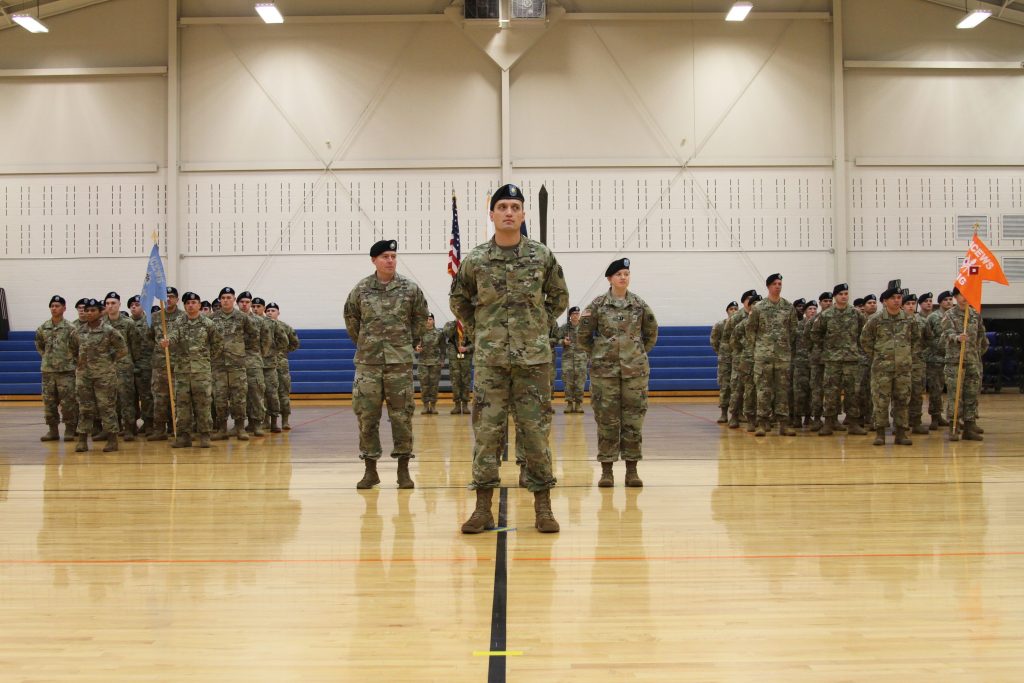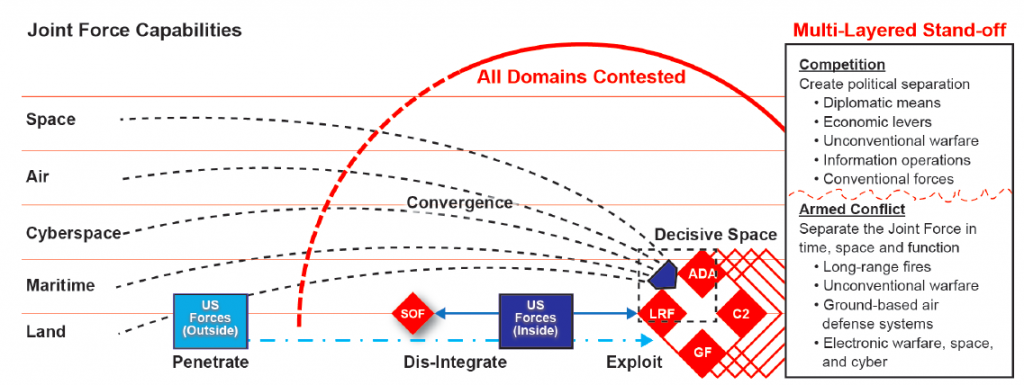
US Army HIMARS (High Mobility Artillery Rocket System) trucks conduct a live fire exercise in Jordan in 2017. HIMARS is central to the Army’s new approach to long-range warfare.
WASHINGTON: The Army has created its first unit to combine long-range targeting, hacking, jamming, and space under one command, a vital component of Multi Domain Operations. The battalion-strength Intelligence, Information, Cyber, Electronic Warfare, & Space (I2CEWS) detachment was created at Fort Lewis, Washington to counter China, while a second will follow in Europe for Russia.

Lt. Gen. Gary Volesky, commander of I Corps at Fort Lewis, tours an Air Force C-17 at neighboring McChord Field.
“Today, we’ll activate the Army’s first I2CEWS detachment,” declared Lt. Gen. Gary Volesky, commander of Fort Lewis-based I Corps, which supports Army operations across the Pacific and would deploy as a Joint Task Force headquarters in wartime. The new detachment, he said, “is the critical unit in the Multi-Domain Task Force” – that’s an experimental Army unit which tests new tactics in the Pacific – “and the centerpiece of how the Army will conduct Multi-Domain Operations in the future.”
Multi-Domain Operations calls for cracking open high-tech defenses with relentless, coordinated attacks from every domain of conflict: land, air, sea, space, and cyberspace, as well as the electromagnetic spectrum. The Army, Air Force and Marines – but not yet the Navy – have all publicly endorsed MDO to different degrees, with the Army the most enthusiastic advocate from the beginning.
So you’d think that the first unit created specifically to conduct multi-domain ops would get a big fanfare from the Army’s top brass. In fact, all the facts we have, including Volesky’s words above, come from an Army story written by a public affairs private – yes, the lowest rank around – and quietly published on two obscure official sites over a week ago. The unit officially stood up at a ceremony Jan. 11.

Soldiers of the Army’s newly created I2CEWS (Intelligence, Information, Cyber, Electronic Warfare, & Space) Detachment stand in formation at the activation ceremony Jan. 11.
Out of Many, One
What makes this so significant? First is the composition of the unit itself. It’s a battalion-sized force led by a lieutenant colonel and made up of four companies, each with its own specialty:
- Intelligence, which, as described, sounds specifically like an intelligence analysis staff, rather than active collectors: “The intelligence team will provide a nuanced understanding of the operating environment and drive both lethal and non-lethal operations,” the Army story says.
- Information operations, which historically the Army has treated as a sideline, more about publishing propaganda leaflets than supporting combat units, even as Russia and China make electronic deception and online disinformation central to their “grey zone” strategy;
- Cyber and electronic warfare, which the Army has long treated as intertwined — all tactical networks are wireless, so both hacking and jamming can affect them; and
- Space & signal, “signal” being the Army term of art for communications, which is intimately tied to space since most long-range transmissions are relayed via satellite. This company could also be the element bringing in intelligence data from signals intelligence and/or reconnaissance satellites.
In addition, the Army story refers to a “long range sensing section [that] will enable [i.e. spot targets for] precision fires and support artillery, air and missile defense.” But it’s not clear where this section falls in the organization: It may be a special “data fusion” cell under the battalion headquarters rather than a company of its own.
Now, the Army was already combining some of these elements by creating cyber/electronic elements at every level from brigade on up. This new battalion is probably the equivalent asset for a corps or theater command. (Both I Corps and the all-service Indo-Pacific Command have oversight). But bringing all these elements together in one unit is unprecedented.
“I hadn’t actually seen the ‘I2’ before, either,” said William Fabian, a former Army officer and Pentagon official now with the thinktank CSBA, said in a phone interview with Breaking Defense. “The addition of information operations (in particular) is interesting. It could be a recognition on the part of the Army that all of this – intelligence, cyber, EW, space, information operations – is all part of a larger competition for information advantage.”
That synthesis has long been central to both Russian and Chinese doctrine. China even created a Strategic Support Force specifically to coordinate space, cyber, information and electronic warfare. US military leaders have taken a long time to catch up to the idea.
Of the American armed services, it’s actually the Air Force, with its emphasis on Multi-Domain Command & Control (MDC2), that’s said the people involved need their own career paths – instead of being shuffled around to unrelated assignments — to preserve their institutional knowledge and highly specialized skillsets. The Army’s not come to that position yet, at least publicly, but the creation of this battalion might be a big first step.
“I know a number of people in the fields represented by the I2CEWS throughout the force who, for years, wanted to see everything come together with a common mission under a single command,” said the detachment commander, Lt. Col. Derek Bothern, in the Army story. “It’s an awesome responsibility to be first.”
See Far, Shoot Far
So what does putting all these pieces together actually do?
First, remember the new unit will be part of the experimental Multi-Domain Task Force. That task force’s core is the 17th Field Artillery Brigade, also out of Fort Lewis, and a second Multi-Domain Task Force will be built around the 41st Field Artillery in Germany. The long arm of such brigades is HIMARS: basically, big trucks carrying launchers for a wide variety of rockets and missiles.
Originally designed to bombard static targets on land, HIMARS recently helped sink a (decommissioned and empty) ship during the RIMPAC wargames. Enhancing such Long Range Precision Fires is the Army’s No. 1 modernization priority. They’re already developing new smart missiles for HIMARS that can hit moving targets, both ground troops and warships, up to 500 kilometers (310 miles) away – probably longer if the US withdraws from the INF Treaty with Russia, as President Trump has promised. With these new weapons, Army and Marine Corps HIMARS batteries, firing from hidden positions on strategically located islands, could play a major role against a Chinese naval offensive.
The problem: Field artillery brigades aren’t trained or equipped to find targets at these distances, not on land and certainly not at sea. Since a blind archer doesn’t hit many bull’s-eyes, the Multi-Domain Task Force has to rely on other units – Army drones, Marine Corps fighters, Navy ships, Air Force satellites – to provide it targeting data. But just getting access to so many sources, let alone integrating everything into a coherent picture of where the enemy really is, is a tremendous task. With the creation of the I2CEWS unit, especially its “long-range sensing section,” the Army will have its own in-house expertise to pull together all the data and tell the rocket launchers where to shoot.
It’s not only offensive missile units that need to know where to shoot, however. The Army story says the sensing section will also support “air and missile defense,” (AMD), the service’s No. 5 priority.

A simplified (yes, really) overview of the Army’s IBCS command-and-control network for air and missile defense.
Historically, every AMD unit relied on its own radars: Patriot batteries had radars optimized to track incoming ballistic missiles, Short-Range Air Defense (SHORAD) batteries had radars to track attack jets and helicopters, and so on. But that fractured system doesn’t cope well with sophisticated adversaries who might launch coordinated salvos of cruise missiles, ballistic missiles, and airstrikes. So, the Army’s developing a new system, IBCS, to plug all its sensors and shooters into a single network: Every battery will share targeting data with all the others, and whichever unit has the best shot at a threat can take it down.
IBCS isn’t fielded yet, but the I2CEWS battalion will presumably use whatever expedients exist to bring together all this information. It’s no coincidence that the military pronounces “CEWS” as “cues,” since that’s precisely what the unit provides to shooters.
But the new unit isn’t just feeding data to missile batteries, Fabian pointed out: It could also take action directly, in cyberspace and the electromagnetic spectrum.
“The new unit supports joint task forces by providing defensive and offensive cyber operations, space capabilities and electronic warfare,” the Army story says. “The space team is designed to support freedom of action in space for friendly forces and deny it to adversaries, Bothern said. The electronic warfare section is expected to open windows of opportunity in the information environment.”
What does that mean in English? It sure sounds as if the I2CEWS unit has the high-tech equipment and highly skilled people to hack an enemy’s networks or jam their transmissions, as well as to counter the enemy’s attempts to hack or jam us.
That’s particularly important for ensuring or denying access to space, since satellites rely on long-range wireless networks to relay communications, transmit the intelligence they gather, and receive instructions from controllers on the ground. While anti-satellite weapons that blow up in orbit get a lot of press, they’re an extremely expensive and escalatory way option. The easiest way to counter enemy satellites is to jam their radio transmissions – so easy the US keeps jamming its own satellites by accident – and the second easiest is hacking their network. Those are both things the new I2CEWS unit can do. If you actually have to shoot a physical missile, the easiest target is the ground control station, not the satellite a thousand-plus miles up – and you’ll need I2CEWS to tell you where to shoot.


























